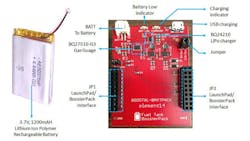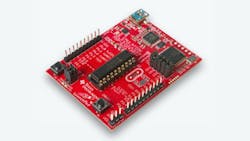Note: We’re offering a free Texas Instruments MSP430 Launchpad and a Newark element 14 Fuel Tank BoosterPack to the first person to answer a question at the end of this article. The answer is in the following text. We prefer to give these to a university or other non-profit organization.
The Fuel Tank BoosterPack is a product developed by Newark element 14, a distributor of technology products, services and solutions for electronic system design, maintenance and repair. This BoosterPack supplies battery power to the Texas Instruments’ LaunchPad development kits (Fig. 1). It allows LaunchPads to be powered from a rechargeable lithium polymer battery, further enabling mobile application development and evaluation.
Related Articles
- Talking Battery Charger Provides User Prompts
- Power Bank – Power On-The-Go (Part 1)
- Power Bank – Power On-The-Go (Part 2)
- Real Time Plus Integrates Real Time Clock and Battery Re-Charger
- Inverter/Charger Supports Grid-Interactive and Off-Grid Applications
The Fuel Tank BoosterPack has two LED indicators – one for Low battery (BATT LOW) and the other to indicate the battery is charging (CHARGING). There are two 20-pin of headers for connection to the Texas Instruments LaunchPads.
LaunchPads are an easy-to-use development tool intended for beginners and experienced users alike to create microcontroller-based applications (Fig. 2). Key to this development tool is the type of microcontroller that is used. One type of Launchpad uses the Texas Instruments’ MSP430™ MCU Value Line series. Its integrated DIP target socket supports MSP430G2xx2, MSP430G2xx3, and MSP430F20xx devices in PDIP14 or PDIP20 packages, allowing them to be dropped into the LaunchPad board for easy programming, debugging, and monitoring. Included are free unrestricted and downloadable software development environments for writing and debugging software. You can use LaunchPads to create interactive solutions thanks to its integrated buttons, LEDs, and extra input/output pins for easy integration of external devices.
This LaunchPad is an affordable, and scalable introduction to the world of microcontrollers and the MSP430 family. The MSP430 is a16-bit microcontroller platform of ultra-low power RISC mixed-signal microcontrollers from Texas Instruments.
Complete Package
The MSP430 LaunchPad includes all of the hardware and software needed to get started. Pre-programmed devices and code examples help users get up and running quickly. The LaunchPad includes a development board, two programmable MSP430 microcontrollers, mini-USB cable, PCB connectors for expandability, external crystal for increased clock accuracy, and unrestricted software integrated development environments (IDEs). The LaunchPad is a simple introduction to the MSP430 microcontroller family. As application requirements change, programs developed on the LaunchPad can be migrated to higher end MSP430 devices.
The BoosterPack can also be used with LaunchPads that employ the Texas instrument Tiva C Series of microcontrollers. This includes the TM4C123GH6PM microcontroller that offers an 80-MHz, 32-bit ARM Cortex-M4 CPU with floating point, 256 kBytes of 100,000 write-erase cycles of flash memory, and a wide range of peripherals including motion control PWMs, 1-MSPS ADCs, eight UARTs, four SPIs, four I2Cs, USB H/D/OTG, and up to 27 timers.
A third type of LaunchPad that will work with the BoosterPack is one that uses a Texas Instruments C2000 32-bit microcontroller. It is intended for high performance integrated peripherals designed for real-time control applications. Its optimized core can run multiple complex control algorithms at speeds necessary for demanding control applications. Powerful integrated peripherals combined with the SPI, UART (SCI), I2C, CAN, and McBSP communication peripherals make C2000 devices the perfect single-chip control solution.
The Fuel Tank BoosterPack works with all existing TI LaunchPads and includes an onboard Lithium Polymer battery charger bq24210 as well as gas gauge bq27510-G3 that can output the critical parameters of the battery. When connected to the LaunchPad, the BoosterPack is able to act as a power source for it and is able to provide the portability and flexibility on applications.
The Texas Instruments bq24210 is a highly integrated 2x3 mm2 single cell Li-Ion linear charger intended for space-limited portable applications. Depending on the status of control pins and source conditions, the IC can operate in several modes: Sleep, Charge, Load, and Suspend. The charger’s high input voltage range with input over-voltage protection supports low-cost unregulated adapters. The IC has a single power output that charges the battery. A system load can be placed in parallel with the battery as long as the average system load does not keep the battery from charging fully during the 10 hour safety timer.
Fuel Gauge
The Texas Instruments bq27510-G3 system-side Li-Ion battery fuel gauge is a microcontroller peripheral that provides fuel gauging for single-cell Li-Ion battery packs. The device requires little system microcontroller firmware development. The bq27510-G3 uses the patented Impedance Track™ algorithm for fuel gauging and provides information, such as:
- Remaining battery capacity (mAh)
- State-of-charge (%)
- Run-time to empty (min.)
- Battery voltage (mV)
- Temperature (°C)
The bq27510-G3 supports an I2C™ for connection to the system microcontroller port. It resides on the system’s main board and manages an embedded battery (non-removable) or a removable battery pack.
At power up the IC performs the operation mode detection automatically and either enters sleep, charge, load, or suspend mode. In charge mode, the charger has three phases of charging: Pre-charge to recondition a full discharged battery, fast-charge constant current to supply the buck charge safely and voltage regulation to safely reach full capacity. The charge-operating mode is very flexible, allowing programming of the fast-charge current, and input voltage regulation threshold. The programmable input voltage regulation threshold makes the IC compatible with many alternative power sources, such as solar panel or inductive charging pad.
Question: How many types of battery information does the bq27510-G3 provide?
About the Author

Sam Davis
Sam Davis was the editor-in-chief of Power Electronics Technology magazine and website that is now part of Electronic Design. He has 18 years experience in electronic engineering design and management, six years in public relations and 25 years as a trade press editor. He holds a BSEE from Case-Western Reserve University, and did graduate work at the same school and UCLA. Sam was the editor for PCIM, the predecessor to Power Electronics Technology, from 1984 to 2004. His engineering experience includes circuit and system design for Litton Systems, Bunker-Ramo, Rocketdyne, and Clevite Corporation.. Design tasks included analog circuits, display systems, power supplies, underwater ordnance systems, and test systems. He also served as a program manager for a Litton Systems Navy program.
Sam is the author of Computer Data Displays, a book published by Prentice-Hall in the U.S. and Japan in 1969. He is also a recipient of the Jesse Neal Award for trade press editorial excellence, and has one patent for naval ship construction that simplifies electronic system integration.
You can also check out his Power Electronics blog.


